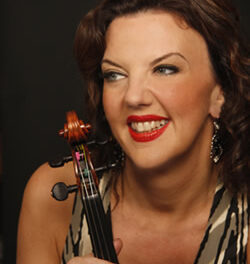In a well-chosen program of works composed or orchestrated in the XXth Century, the excellent Greensboro Symphony moved from melancholy, through introspection and despair to triumph in the unfamiliar setting of Aycock Auditorium on the University of North Carolina’s Greensboro (UNCG) campus. The concert will be repeated on Saturday, January 24, in a different location, Dana Auditorium, on the campus of Guilford College at 8 pm.
A small but enthusiastic audience braved the wet and wintry weather to hear Music Director Dmitry Sitkovetsky in his star role as virtuoso violin soloist in the monumental First Concerto, Opus 77, by Dmitri Shostakovich (1906-1975). Maestro Sitkovetsky, a phenomenal violinist, rules this concerto, which Shostakovich wrote during the worst days of Josef Stalin’s regime but locked in a drawer until after the dictator’s demise in 1953. It is a huge and magnificent work of symphonic proportions (four movements) and one of the most demanding in the violin repertory. Shostakovich uses biographical material in very original ways, incorporating anagrams and themes from other works, both his own and by other composers in manners which are very gripping.
The first movement (Nocturne) of this violin concerto is slow and introspective with wondrous dark and melancholy sounds from the depth of the orchestra. Maestro Sitkovetsky is a master of setting and maintaining this mood so typical of one side of Shostakovich. Another side of Shostakovich is typified in the second movement, Scherzo (“Joke” in Italian), but a frenetic scherzo with a diabolic side to it (recalling the Devil’s Dance in Stravinsky’s 1918 Histoire du Soldat), a dance in the face of death. Again, pacing from side to side and front to back between the conductor’s podium (gracefully and effectively occupied by GSO Resident Conductor Nate Beversluis for the concerto) and the first stand of string players, soloist Sitkovetsky made the music happen, dancing as the rhythms became irregular and stomping silently to emphasize a strong beat.
The third and longest movement of this intriguing concerto is a slow Passacaglia, that again plumbs the “depth and breadth and height [the] soul can reach, when feeling out of sight for the ends of being..” This extraordinary movement ends gently and leads seamlessly into one of the most extraordinary solo cadenzas ever written – and certainly the longest and most difficult for violin! From the quiet start the cadenza builds in intensity and tempo until the tension is at its extreme and soloist and audience alike are taut to the breaking point, when finally the timpani interrupts and launches us into the brief concluding Burlesque. This extraordinary tour de force was met by an instantaneous roar and standing ovation!
The entire second half of the concert was filled by a musical visit to the now classic museum piece, Maurice Ravel’s extraordinary orchestration of Modeste Mussorgsky’s (1839-1881) piano masterpiece, Pictures at an Exhibition. The eleven movements, depicting watercolors and sketches by Mussorgsky’s friend, Viktor Hartmann, are loosely strung together by a walking tune (Promenade), which changes depending on the mood of the viewer after the previous picture. Here the orchestra is the focus of attention and the excellent playing of the principal players of the Greensboro Symphony was impressive. Each section was at its best – the strings precise and quick in the “Tuileries” and as gossipers in the “Market at Limoges,” woodwinds incisive as the “Unhatched Chicks,” brass in the “Promenades” and especially in the mysterious “Catacombs,” and all in the stately “Great Gate of Kiev” which provides a fitting climax and conclusion to the half-hour war horse. Several solos were outstanding: Steve Stusek (saxophone) in the “Old Castle,” Anita Cerba (trumpet) as the simpering schnorrer, “Schmuÿle,” and Brian French (euphoneum) in “Bydło,” the lumbering Polish oxcart.
The entire concert began with one of Maurice Ravel’s (1875-1937) most exquisite compositions for piano, Pavane pour une infante défunte, (Pavane for a Dead Princess) which he orchestrated in 1910. Maestro Sitkovetsky chose to give weight and dignity to this six-minute piece that brought tears to the eyes of a fellow listener. This was gorgeous playing, especially the opening solo by principal horn, Robert Campbell, and the lush and rich pianissimi of the strings.
A brief word about the recently refurbished Aycock Auditorium; Apart from some “front-of-house” issues (public address system which didn’t work, some double-booked seating for the second week in a row), the orchestra must have strained due to the lack of adequate lighting. Indeed, although the black floor, deep mahogany acoustic shell panels and burgundy curtain brought out the beauty of the string instruments, the overhead lights were spotty providing only “dimples” of light on stage.
Acoustically, the audience sitting on the main orchestra level is deprived of most of the “presence” in the sounds of the woodwinds. This was much improved when I moved into the middle of the balcony at intermission. Both the sound of the orchestra and the sight lines are considerably better in the balcony.
Although the seats are tight for the long-legged, the steps are easily navigated, unlike the steeply raked steps at the Stevens Center (Winston-Salem). Perhaps the clouds (acoustic baffles above the orchestra) need to be reconfigured to give advantage to upstage instruments, and most probably the proscenium arch curtain should be raised as high as possible. Although the entire season’s publicity seems to have been inspired by the television series “Breaking Bad,” I am happy to report that there was no evidence of crime or otherwise unsavory characters in this concert.











